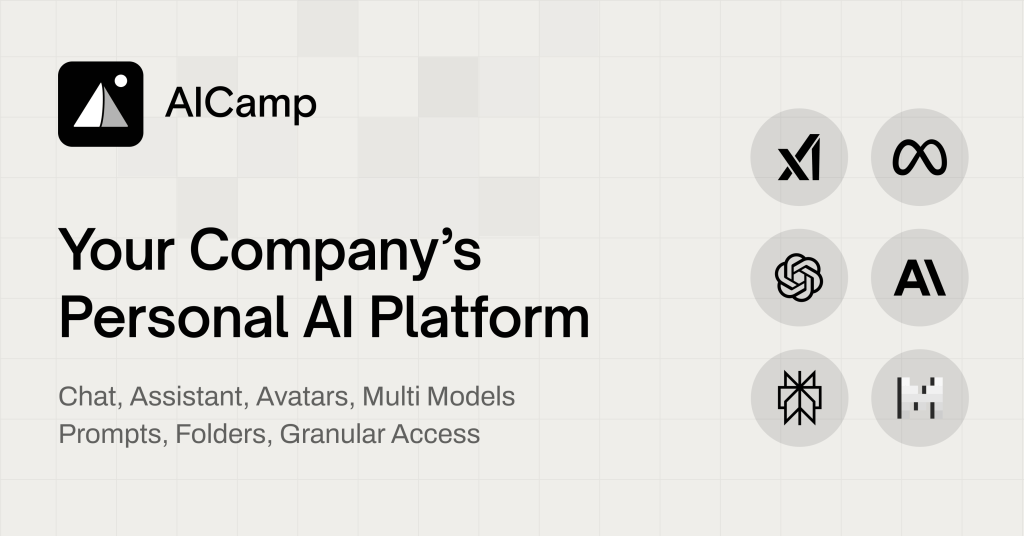We can all agree that effectively managing API access is crucial for protecting sensitive data and controlling costs.
By following best practices around OpenAI API key permissions, rotation, tracking, and access control, you can securely provide platform access across your teams.
In this post, we’ll cover key concepts and actionable strategies for centralizing and optimizing API key management, including integrating with your MLOps and maximizing billing efficiency.
AICamp – Your Company’s Personal AI platform

Introduction to OpenAI API Key Management
Managing OpenAI API keys is crucial for teams to control access, prevent misuse, and optimize usage across members. API keys act as the gateway to AI models, so putting a governance strategy in place is the foundation for success.
Understanding OpenAI API Keys
OpenAI API keys, including ChatGPT keys, authorize access to OpenAI models and services. They allow you to integrate cutting-edge AI into apps and workflows. Teams require API keys to unlock AI capabilities, but with shared access comes the need to manage them responsibly.
API keys connect your app or account to OpenAI resources and billing. Anyone with the key can use it, so you must control who has access to prevent overages or misuse. Proper API key management ensures you get the most from your OpenAI investment.
Centralizing API Key Management: Why It Matters
Central control over API keys enables:
- Access Management: Ensure only authorized team members have access to AI resources.
- Usage Monitoring: Track usage to optimize costs and prevent billing spikes.
- Compliance: Maintain control and oversight for security and regulatory requirements.
- Collaboration: Share access and insights across team members working on shared projects.
As teams scale their use of AI, API key management and analytics become essential to maximizing value.
How to Get an OpenAI API Key: The Starting Point
To start, you’ll need to:
- Create an OpenAI account
- Subscribe to a plan or add billing details
- Generate an API key in your account settings
Document and securely store new keys for internal reference. Consider assigning keys to help track usage by team, project, or application.
With keys created, focus next on setting up your overall organization and access controls.
Setting Up Your Organization for API Key Success
Use organization settings to manage team members, projects, API keys, and billing in one place. Take time initially to:
- Name and organize teams and internal groups
- Assign user roles and permissions
- Provision keys to integrate into apps and services
- Set API usage limits and quotas as needed
This organizational foundation is key to maximizing collaboration while maintaining oversight of AI resource utilization.
How to get OpenAI API key for free?
Unfortunately, there is no free tier for the OpenAI API. All API requests incur usage charges based on the amount of data processed.
However, OpenAI provides new users with $5 worth of credits when you first create an account. You can use these credits to make API requests for free.
Here are some key things to know about getting started with OpenAI credits:
- The $5 credit expires 3 months after account creation. So be sure to use it within the first few months.
- Monitor your usage to avoid unexpected charges once the credit runs out. OpenAI provides usage dashboards to track consumption.
- The credit applies to most OpenAI API endpoints like text and image generation. But you cannot use it for custom model training.
So while there is no perpetual free access, the OpenAI credit allows you to test out the API risk-free. You can build prototypes and small projects to evaluate if the capabilities suit your needs before committing budget.
Just be conscious of the short expiry and usage limits to make the most of the trial credit.
Is using OpenAI API free?
No, using the OpenAI API is not free. There is no “free account” option – all usage of OpenAI models and services costs money based on the amount of data processed.
However, OpenAI does offer a free trial credit for new users to experiment with the API services. This free credit expires after 3 months from when you first create an OpenAI account.
Once the free trial credit has expired, you will need to add funds to your account’s credit balance in order to continue making API calls and using OpenAI services. Usage is metered based on factors like:
- Number of tokens processed
- Compute time
- Number of API calls
As your usage increases, so will your costs. Carefully monitor your monthly API usage to avoid unexpected charges.
Here are some best practices around managing OpenAI API costs:
- Set a monthly budget cap and enable alerting when you approach that level
- Restrict access to API keys to prevent overuse
- Rotate API keys periodically to control access
- Analyze usage metrics to optimize your requests
- Use cheaper models when possible for less intensive workloads
While extremely powerful, the OpenAI API is not a free resource. Careful management of your API keys and usage is important to control expenses.
How do I get a ChatGPT API key?
Well, ChatGPT is GUI interface powered by openAI.
How can I use OpenAI API in my team?
With AICamp you can connect API and use them with your team. That would be cost efficient and easy to use. Learn here how you can do it.
Are OpenAI API keys safe?
OpenAI API keys provide access to powerful AI models, so it is crucial to keep them secure. Here are some best practices:
Use key rotation
Rotate API keys periodically to reduce the blast radius if a key gets compromised. You can easily generate new keys and revoke old ones through the API dashboard.
Restrict key permissions
When creating API keys, restrict permissions to only what is necessary. For example, restrict a key to only allow text completion instead of full access.
Manage access carefully
Only share API keys with team members that need them. Don’t check them into public source control. Consider using a secrets management system.
Monitor usage
Keep an eye on usage logs to detect any suspicious activity that could indicate a compromised key. Set up alerts for spikes in traffic or unusual times.
Use IP allowlisting
You can restrict API key usage to only specified IP addresses or ranges through allowlisting. This limits damage if a key leaks outside your infrastructure.
Following these best practices will help ensure your OpenAI API keys remain secure and prevent unauthorized usage. Let your team focus on creating value with AI while you handle governance in the background.
Best Practices for OpenAI API Key Safety
Managing API keys is crucial for securing access to AI models like OpenAI’s platform. Following best practices allows you to govern usage, prevent misuse, and scale your architecture effectively.
Assigning API Key Permissions with Precision
Granular role-based permissions ensure users only have access to features they need. For example:
- Admins have full access to add/revoke keys and manage permissions
- Developers can access certain models to build applications
- Analysts have read-only access to generated analytics
Set permissions when first creating an API key. Revisit as new users and roles emerge.
Key Rotation: Enhancing Security Practices
Rotate API keys periodically, like every 90 days. This limits damage if a key gets exposed.
Automate rotation with tools like Terraform to avoid disruptions. New keys take effect automatically, while old ones are revoked.
Tracking API Key Usage: Managing Billing and Usage Limits
Dashboard tracking provides visibility into:
- Volume metrics – requests, characters processed, etc.
- Costs – accrued charges to date
- Rate limits – remaining calls before throttling
Get alerts for unexpected spikes so you can investigate potential misuse.
API Key Management Dashboard: Your Control Center
A centralized dashboard to control API keys such as:
- Key creation/revocation
- Permission assignments
- Usage metrics per key
- Billing visibility
- Access logs
Streamline coordination between admins, developers, and end users. Maintain tight governance as your program scales.
Following structured best practices for API keys enables secure, controlled access to AI capabilities for your entire organization.
Integrating OpenAI API Keys into Your MLOps Strategy
Managing OpenAI API keys across teams can be challenging, but implementing an effective MLOps strategy with proper access controls and architecture best practices can streamline API key usage.
Access Control: The Foundation of API Key Security
Using an identity and access management (IAM) solution like Auth0 or Okta to enforce permissions is crucial for securing OpenAI API keys. With role-based access controls, you can ensure users only have access to specific API keys based on their responsibilities. Multi-factor authentication adds another layer of protection.
Regularly rotating API keys and having an audit trail of key usage also helps maintain security. Make sure to have processes in place for secure key rotation and access revocation.
Scaling Your Solution Architecture with OpenAI API Models
As you incorporate different OpenAI API models like ChatGPT, Claude, Codex, and DALL-E into your architecture, implement separate keys and usage limits for each service.
Horizontally scaling with load balancers helps you handle increased traffic to certain models. Modular microservices for each API model also makes development and testing easier.
Staging Accounts and Production Best Practices
Maintaining separate staging and production OpenAI API keys prevents accidents and allows testing. Restrict key access in production to only essential personnel.
Follow security best practices like encrypting keys, using VPCs, and enabling anomaly detection to protect production keys. Analyze usage data to right-size production keys.
Containerization: Modularizing API Key Access
Containerized microservices with Docker and Kubernetes facilitate granular API key access and deployment. Key usage is isolated and modularized, easing testing and allowing you to specifically grant access per service.
Network policies and namespaces provide additional access control layers. With proper containerization, you can securely scale OpenAI API usage across your architecture.
Advanced API Key Management Techniques
Managing OpenAI API keys for large teams or complex projects requires more advanced techniques to ensure security, control costs, and optimize usage. Here are some key strategies to consider:
Automating Key Rotation for Enhanced Security
Rotating API keys on a regular schedule is a critical security practice. Doing this manually for multiple keys can be cumbersome. Consider automating key rotation using scripts or tools like:
- OpenAI’s CLI and API to programmatically generate and manage keys
- CI/CD pipelines to handle key rotation as part of deployment
- Third-party services like HashiCorp Vault for secrets management
Automated rotation ensures keys are refreshed consistently, reducing the risk of compromised access over time.
Managing Billing Limits to Control Costs
Unchecked usage of large AI models can quickly consume API quotas and incur unexpected charges. Set custom billing alerts and limits in your OpenAI account dashboard to prevent surprise bills.
Assign sub-limits to groups or individuals as needed. Track usage against these limits using the dashboard or usage reports. Suspend keys nearing their limits to control costs.
Enforcing Rate Limits to Ensure Fair Usage
To prevent any single user from overusing shared keys, enforce rate limits in your app logic or through API gateways. This ensures fair quota usage across your team.
Consider a staged rollout when launching new models to progressively ramp up traffic as you monitor adoption and spending.
Team Page: Centralizing Team Access and Management
Use OpenAI’s Team Page to easily add collaborators and manage what models they can access. Set custom roles like “Viewer”, “Builder” or “Admin” to control permissions.
Centralized management on the Team Page makes it easy to quickly modify access, assign quotas, or rotate keys for your entire organization.
With these advanced practices, you can scale OpenAI usage across large teams while keeping costs, security, and fairness in check, no matter the complexity of your projects.
Conclusion: Key Takeaways in OpenAI API Key Management
Summarizing API Key Management Best Practices
Managing OpenAI API keys for teams requires implementing access controls, monitoring usage, and establishing governance policies. Best practices include:
- Assign API keys to individual users or applications to track usage
- Set appropriate permissions and limits for each API key
- Rotate keys periodically to reduce risk from compromised credentials
- Analyze usage metrics to optimize allocation of API resources
- Centralize control through a dashboard for managing API keys
- Document processes for requesting, distributing and revoking keys
Following these practices ensures efficient, secure and compliant usage of OpenAI capabilities across an organization.
Action Plan for Implementing an API Key Management Strategy
To roll out API key governance:
- Start by auditing existing keys to understand allocation status
- Build a dashboard to centrally control API credentials
- Set budgets, alerts and quotas aligned to team priorities
- Communicate new processes for access requests and approvals
- Phase key rotation to minimize disruption
- Provide training on responsible API practices
Continually refine policies as OpenAI usage evolves across the organization. Monitoring analytics and responding to user feedback enables ongoing optimization.














